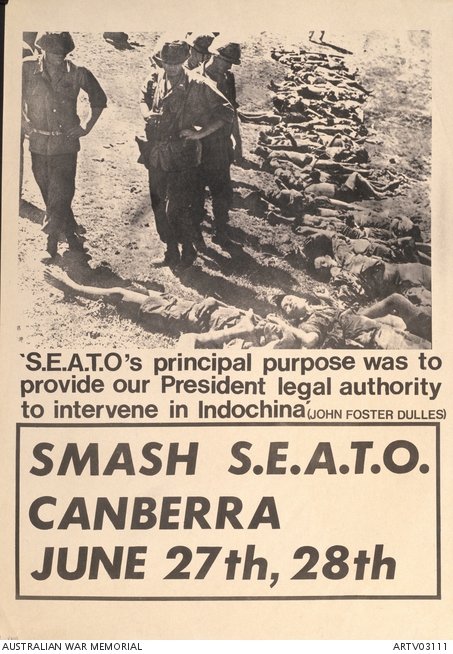| Places | |
|---|---|
| Accession Number | ARTV03111 |
| Collection type | Art |
| Measurement | Overall: 48.2 x 34 cm |
| Object type | Poster |
| Physical description | letterpress and photoengraving on paper |
| Maker |
Unknown Unknown Unknown |
| Date made | c 1968 |
| Conflict |
Vietnam, 1962-1975 |
| Copyright |
Item copyright: External copyright |
Smash SEATO

Depicts a line of US soldiers inspecting the laid out bodies of dead Vietnamese children. The accompanying text advertises a rally in Canberra and contains a quote from John Foster Dulles that SEATO's principle purpose was 'to provide our president legal authority to intervene in Indochina'. The Southeast Asia Treaty Organisation (SEATO) was an alliance organised in September 1954 between Australia, France, Great Britain, New Zealand, Pakistan, the Philippines, Thailand and the United States. It was established under Western auspices after the French withdrawal from Indochina and was created to stop communist gains in Southeast Asia. The civil and military organisations established under the treaty had their headquarters in Bangkok. Unable to intervene in Laos or Vietnam due to its rule of unanimity, the future of the organisation was questioned during the early 1970s and it was disbanded in 1977. John Foster Dulles (1888-1959) was an American statesman and anti-Communist. After graduating from university he joined a New York law firm, specialising in international law. In 1918 he was appointed as legal counsel to the United States delegation to the Versailles Peace Conference. He helped draft the preamble to the United Nations Charter and subsequently attended the General Assembly of the United Nations as a United States delegate in 1946, 1947 and 1950. He was Secretary of State under President Eisenhower from 1953-59 and together the two men pursued a policy of strength toward the Soviet Union and communist China. He also spent considerable time building up NATO as part of his strategy of controlling Soviet expansion by threatening retaliation in the event of war. Dulles was also the architect of the SEATO, which, created in 1954, 'provided for collective action against aggression'. He resigned from office in 1959, suffering from cancer.